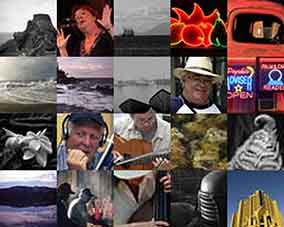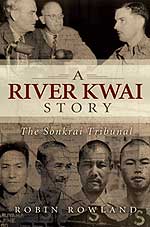Red winged blackbird at the Don Valley Brick Works.
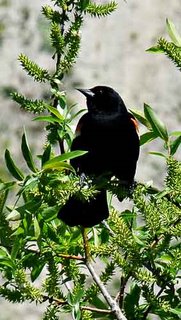
More photos from the Brick Works hike in my public Facebook album.
All images are copyright Robin Rowland 2009. Do not download or reuse without permission.
Labels: birds, photoblog, photography
Professional photographers are, to use the football term, hearing footsteps from the citizen journalists, fearing their jobs are threatened by “user generated content.”
Now there’s a new threat, the whine of the servos and motors of a robot.
On Saturday Jan. 24, I went to shoot a yearly assignment, the Canadian Toy Association's Toy & Hobby Fair at the Metro Toronto Convention Centre.
I always wonder through the corridors between the booths and the big displays first at the trade show to look for the best toys to create a photo gallery. Not necessarily the hot toys of the year, but the ones that will be best for the gallery.
Almost as soon as I arrived there it was, a small almost insectoid robot making its way slowly but surely across a deep pile carpet.
I dropped to my knees, raised by camera and click,

click

click,

click.
Then the salesperson controlling the little ‘bot motioned me over to the counter where he was working a laptop.

Turned out the robot was shooting me as I was shooting the robot.

It’s the Spykee Spy Robot from the French arm of Meccano, a robot that has its own website at http://www.spykeeworld.com/ (Both Meccano and the U.S. Erector firms are now owned by the same company).
I was at a toy show, where I was tracked by a robot that can record audio and video.
I was recorded by a Meccano set! When I was a little kid, I got a Meccano set under the tree, girders and big screws that might make something that somewhat resembled an oil rig or a small girder bridge.

The control panel.
The Spykee Spy Robot can be controlled from anywhere on the planet (and possibly beyond) using internet WiFi connections.
The video quality wasn’t that good.
My immediate thought was wait six months and it will get better.
Then I realized, it’s a Meccano set. Someone with enough technical skill could probably convert it into a broadcast quality video and audio or print quality 200-300 dpi still image newsbot.

I left the show with the instructions for building the robot kit.
According to the website, the Spykee can also carry its own Ipod. So even if it’s a robot, it can ignore you just like humans do when they are in the world created by their Ipod.
A child can do it. Meccano says it's for ages 8 and up.

You can set up your laptop at a WiFi hotspot and control the bot. The Spykee website shows someone controlling a robot in Paris from New York.
There goes the Paris bureau. You can be replaced—by a Meccano set
Yes, you can imagine the beancounters sending in robots so they won’t have to pay salaries (just a little maintenance).
Newsbots have been a staple of science fiction since the 1940s. I remember stories of paparazzi robots chasing their targets, showing live video or sending pix back to an office.

A future Rover on Mars. (NASA/CalTech)
NASA has already created robots that are on Mars at the moment, sending back high quality images and robots that will head to the Red Planet will have even better images.

Three generations of Mars rovers. (NASA/CalTech)
Military forces in the developed world are planning combat robots. The Predators and other drones are in action over Afghanistan and Iraq. Iin Gaza, those reporters who were there often told of the constant noise of Israeli drones flying over Gaza.
With the Israelis blocking human journalists from getting into Gaza, why not send in the robots? Of course, combatants in a war zone would likely try to destroy the newsbots. And the newsbot would have to have a satellite link since all the WiFi cafes would be rubble. On the other hand, newsbots are relatively cheap and getting cheaper. So news organizations could send the robots into dangerous situations where humans might not want to go, heavy combat, forest fires, natural disasters.
It comes down to how the robots are managed, doesn’t it?

Here"s anoher look at the robocam image. Just for fun I converted it to black and white in PhotoShop and then applied the G-Force filter that is said to emulate Tri-X film. Not much difference between the robocom image and a picture taken with a very cheap camera loaded with good old Tri-X. And as I said, wait six months.
Technorati tags
robot, journalism, photography, Meccano, Erector set,video journalist, spybot, Tri-X, war,
Labels: camera, film, Meccano, photography, photojournalism, robot, spy, toy, Tri-X, videojournalism
 Click on image for full size view.
Click on image for full size view.(If the sun lost 15 per cent of its power, there would be another ice age)
When a computer becomes a photo editor.
From Google News, approximately 1100 ET Nov. 14, 2008
Labels: climate change, Google, news, photography
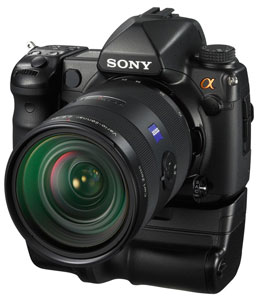
I covered the Toronto launch of the Sony Alpha 900 today Tuesday, Sept. 9. 2008.
*24.6 megapixel full frame sensor
* 5 frames per second capacity, recording capacity at continuous 11 images at raw 105 at jpg extra fine
Sony is saying their new viewfinder based on refinement of an old Minolta system is the best around.
My report on the launch is at
Sony fires new volley in pro camera war
I had only had a brief hands on, had to get back to the office to file.Sony handed around the bare bones body to show how light it was. But in the hands on session, with the all the bells and whistles stuffed into the chasis and the lens, it was just as heavy as any other DSLR.
As well as the two new lenses announced todaythe 70-400 and the 16-35, their sales people were enthusiastic about 135 2.8 STF prime lens which they said was a revamp of a popular Minolta lens. That was the one I tried and in those few moments really liked it, especially using the new view finder.
Sony is also offering a fully pro flash with a wireless system where you can control the ratio of multiple flashes from the camera. And finally a proper converter for the pocket wizard to the Sony proprietary flash system.
Price is a lot lower than expected $3300 Cdn MSRP body only with cameras available in November.
Sony's prime marketing seems to be aimed (at least from what they said at the launch) at fashion, advertising and product photography. (Although Sony is using photographs shot around Banff for their world wide Alpha 900 promotion campaign.)
I have heard from a couple of fashion shooters that some of their colleagues in Europe are switching to Sony from Canon.
One of the demonstrators, an ad photographer, said "You don't need this to shoot sports." Not exactly the most diplomatic statement--and I am sure folks on the sidelines would disagree.
Now if I wasn't spending all that money in energy retrofits for the house I would be preparing to buy some new toys in November, Well may be the spring, if I have the $$$$.
Technorati tags
Sony, journalism, photography, Alpha 900, Minolta,
Labels: Alpha 900, photography, photojournalism, Sony
For me the most fascinating talk at the David Lean Conference at Queen Mary University in London last last month (where I was speaking on The Bridge on the River Kwai) was by Linda Kaye, a senior researcher at the British Universities Film and Video Council.
Here's an abstract:
In January 1930, when David Lean was 21, he joined Gaumont Sound News as a cutter. He honed his editing skills at a time of rapid transition, as the sound revolution began to transform the film industry. Linda Kaye offers a unique insight into this experimental environment, which was to prove a key formative period in Lean's development. Linda Kaye is Senior Researcher on the 'David Lean and Gaumont Sound News' project at the British Universities Film & Video Council.

My emphasis on the word cutter.
For someone who has spent a great deal of my career in television news, Kaye's presentation was a "hey this is really neat" moment. How many times have I sat in an edit suite, going back to my first VO edit at CTV News (Remembrance Day viz from Ottawa in November 1988) on huge machines of two inch reel to reel video tape, then through Sony betacam to todays' desktop television editing on computer and server?
Well, here is where it all began (at least in the UK).
Kaye explained that in the transition from silent to sound came just at the same time as newsreels were coming alive, the "editor" was closer to what today we would call a news producer. What today we would call an "editor" was called a "cutter."
(And interestngly enough today there is a widely used Avid editing product called Newscutter. )
The special website David Lean and Gaumont Sound News (launched on August 1, 2008, just after the conference) takes you through the earliest days of editing news for the big screen.
There was a race in 1929 and 1930 in a highly competitve market to get the first news with sound on film (SOF or today SOT sound on tape) before the public.
If you want to skip the history (you really shouldn't) and just want to watch the news, you will find the Gaumont archive here.
Watch the item on a 1930 match play golf tournament and ask yourself just how different is it (if you forgive the muddy sound for a moment) with today's live coverage of a golf tournament with all cameras on Tiger Woods.
Listen to Stanley Baldwin warning about the deficit and the need for a balanced budget. (how little has changed! It's black and white not colour, otherwise, it's network news.)
Then there's BREAKING NEWS. "Breaking news" wasn't used, of course, but probably this was the first time the term would have meant something in film/video journalism (unlike today where "breaking news" is so over used that the public is beginning to ignore it). Unfortunately the clip is not on the website but here's the description:
The British R101 airship crashes at Beauvais, France with the loss of 48 lives including a Cabinet Minister. David Lean recalled recording the commentary for the first edition of Gaumont Sound News released early that evening. The newsreels claimed to beat the press to the news story of the year.
Business news combines with street actuality and natural sound (with no idea of the long term consequences of what is happening) with the collapse of the German economy and a run on a Berlin bank in 1931
It's part of a larger project co-sponsored by ITN and Reuters to put many of the old British newsreels on the web. It's called the News of the Twentieth Century Project and you can see British news from the 1920s until the 1970s.
Memo to newspaper managers: Watch the Oscars
Watching those first newsreels cut by David Lean and those other young men (as far as I know there were few young women in the field at the time) from their late teens to early twenties all those years ago, made me think about my newspaper colleagues who are jumping into video.
Video is the latest saviour for newspapers, especially in the United States where newspaper industry has been grossly mismanaged by their corporate overlords. The same emphasis on video is happening in Canada where, so far, newspaper corporate management seems to have kept their heads on their shoulders.
And figures do show that page views on newspaper pages does go up if there is video.
I have seen some great video on newspaper sites. But in many cases, the editing of some of that newspaper video is not as good as the work from those teenage film editors in 1930.
The difference is editing.
Lean first made his mark as a newscutter. He then became a feature film editor. He directed his movies with editing in mind. He directed Oscar winning movies with editing in mind.
So, at work the other day, I stopped an editor friend of mine in the hall and asked her, "How long does it take to become a good editor?"
An executive producer just happened to be passing at the time and she said, "Ten years," as she walked by.
My friend the editor nodded in agreement. "Anyone can read a software manual," she said. "Anyone can top and tail. (cutting a one shot sequence so it is at the beginning you want and the ending you want-RR) But it takes along time to know how craft a piece." (And I would add, save the reporter's or producer's ass if something wasn't shot or not shot properly)
Yet this is the typical job ad we see for newspapers today:
A minimum of xxx years experience in photography is required, training or education in photojournalism and video production is an asset expertise with PhotoShop, Final Cut Pro, slideshows and video is required
I recently saw an ad for a journalism professor at an American university that demanded both a Phd and expertise in Final Cut Pro. (Can you do both at the same time???)
Once, not long ago, a young photographer would pay his/her dues, gain experience, find a style in smaller newspapers before working up to a major metropolitan daily newspaper (like The Daily Planet).
In many ways, today's system works better for young talent. In the desperate search for the younger audience, news organizations are hiring young talent and the good ones are working at their full potential in major news organizations (at least until the next round of layoffs)
Newspaper managers are expecting people to read the manual for Final Cut Pro (newspapers are Mac based operations) and then produce quality work. A tiny talented few can. Many others can't and most will take years to learn the craft. (Only at that point does TV have to watch out. But TV managers get ready)
So newspaper managers mark your calendar so you have time to watch the Oscars. Some star opens the envelope for best achievement in editing. And another star opens the envelope for the best achievement in sound editing.
Then, newspaper manager, ask yourself, if anyone can do this, why are there Oscars for those fields?
Let the shooters shoot. If they're good at stills let them shoot stills. If they can shoot both stills and video beware of multitasking (when I see newspaper colleagues trying to do both I keep wondering, are they going to miss the good video moment when they are shooting stills and miss what what be an award winning still photo moment while fiddling with the video camera?)
So hire a newscutter to edit the video your folks shoot.
Who knows that kid you hire might win an Oscar one day (after that kid moves from news to the movies)
Links to this blog post
Peter Power
This was England by Paul Gorbould
Technorati tags
writing, journalism, A River Kwai Story, Bridge on the River Kwai, David Lean,film, photography,photojournalism, videojournalism, Gaumont Sound News, book
Labels: A River Kwai Story, Avid, Bridge on the River Kwai, David Lean, film, Gaumont Sound News, Mac, news, photography, photojournalism, talkies, videojournalism
Promotion for A River Kwai Story, from my agent Waterside Productions.
Australian publishers Allan and Unwin will reveal the long-held secrets of the River Kwai Story in their April 2008 publication of A River Kwai Story, The Sonkrai Tribunal by Waterside Author Robin Rowland.According to the author, more prisoners of war died at Sonkrai than any other camp on the infamous River Kwai Railway. The seven thousand Australian and British prisoners of war who comprised F Force were sent by the Japanese to build the toughest section of the railway in the mountains between Thailand and Burma. More than three thousand people died from slave labour, disease, starvation and exposure to the never-ending monsoon rain.
In 1946 seven former guards from the infamous River Kwai camp were put on trial for their lives before a military tribunal in Singapore, charged with the deaths of more than three thousand people. The account of the trial tells for the first time the story of F Force from all sides-Australian, British and Japanese-from the lowest private to the lieutenant colonels in command. The testimony, verdict and the surprise sentence shed new light on what really happened on the Railway of Death.
A River Kwai Story, The Sonkrai Tribunal is much more than a story of the infamous Railway of Death during the Second World War. The book is about the fairness of military tribunals/trials/commissions in cases where there are atrocities and heavy loss of life. As the United States begins trials of alleged terrorists at Guantanamo Bay, the reader discovers that the story of the River Kwai, known best through David Lean’s Oscar winning movie starring Alec Guinness and William Holden, is as relevant as tonight’s evening news, for the events on that railway led to military tribunals with almost the same rules of evidence and the same charges of unfair proceedings as are the trials now on at “Gitmo.”
Photography
Third place, Feature photography, Clips contest for November 2007, from the Eastern division of the News Photographers Association of Canada.
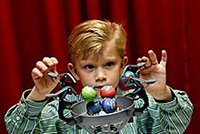
Technorati tags
writing, journalism, Burma Thailand Railway, World War II, F Force, Prisoner of War, military tribunal, photography, book
Labels: A River Kwai Story, Allen and Unwin, Burma Thailand Railway, photography, photojournalism, writing
At this moment the Canadian dollar has fallen back even with the United States dollar.
One US greenback may no longer be worth $1.10 Cdn, as it was when a friend of mine was up from New York a couple of weeks ago but it's at PAR. $1=$1.
So how's this for yet another big cross-border rip off.
I really like my new Sony A700 camera. Not so sure about Sony.
And the one additional feature that most A700 users want is the vertical grip, that is just that a vertical grip --but it also has space for two batteries.
The manufacturers list price has been $399.99 in Canada and $349.99 in the US.
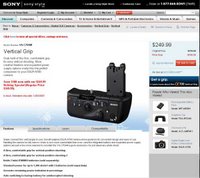 It isn't any more.
It isn't any more.Sony US is selling the vertical grip through Sonystyle.com at $249 and giving US customers free shipping up until December 31.
Here's the page from the US Sony style site,
but in Canada it is still $399.99 and no free shipping through the Great White North.
Here's the Canadian URL
And just for the record at the moment $1 Cdn = 111.04 Yen, $1 US =111.11 Yen. Not much of a difference is there???
Technorati tags
photography, Sony, Alpha 700, Canadian dollar
Labels: Ajpha 700, Canada, dollar, Minolta, photography, photojournalism, Sony, United States
CBC technology blog post How about a HDTV with that DSLR?
It begins with my first SLR.
When Minolta made the announcement that it was going out of business, I wrote a longer version of my experiences with Minolta in my blog post The End of the Minolta Era.
Here's a slightly updated summary:
My father gave me my first SLR, a Minolta SRT 101 for my 18th birthday many years ago.
That camera took me right across Canada in the summer of 1969 from Montreal to Victoria, across Canada to Halifax and then back to Montreal. I was part of the first Aventure Canadienne, one of Pierre Trudeau's first experiments in bilingual and bicultural exchange, twenty students, half Anglophone, half Francophone going across Canada in two blue minibuses.
I used the SRT 101 in journalism school and on my first job as a reporter/photographer on the Sudbury Star, and then I took it across Europe a year later. I took the SRT 101 with me for the year I worked in London,where it survived being tossed across a room by a crazy landlady.
In the early 1980s, bought the Minolta X700 just before I moved into broadcasting and used that camera for years...mostly landscapes since I wasn't shooting journalism at that time.
For video I used a Sony Hi8 camera to shoot my documentary for CBC's Pacific Rim report on my trip up the River Kwai and later bought a Sony DV camera).
I bought a Minolta Maxxum 4 around 2000 or so and added a Sigma zoom and a Minolta 50mm.
At the time when Canon and Nikon and other camera companies were going big on high end, professional digital, Minolta stood still--one reason they got into to business trouble.
I probably would have switched to Canon except for the fact that in October 2005, Minolta Canada went out of business before the company's other branches which closed down in January 2006.
That meant the retailers here in Canada wanted to dump their Minolta cameras and lenses (they didn't foresee the deal where Sony bought Konica-Minolta digital camera technology and patents)
So I got the 7D for $1000 instead of $2000, got a better mid range zoom and a wide angle and a flash --all at less than half the price it would normally have cost.
It appears that elsewhere around the world no one dumped Minolta lenses at fire sale prices after the Sony deal was announced-- the retailers knew the lenses were good for the upcoming Sony cameras.
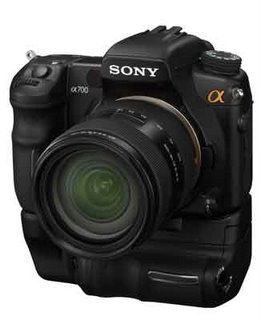
So I have now all this equipment and most of it is compatible with the Sonys--and if, from time to time, I want to shoot film, most of the lens and equipment will work with the Maxxum film camera. So I am going to stick with cameras I know, know how to operate and like using.
I didn't have much time last Thursday for the hands on session with the Alpha 700. You will find a review from Doug Brown on the DPreview forum here.
Among the features that stood out for me in the Alpha 700 were:
The presenters were pushing a function key system that means you don't have to stop and look at the menu in midshoot.
Both in the PR book and the presentation Sony said the in camera image stabilization system is made to work with any lens--in other words all the Minolta lenses out there just waiting for a new digital camera.
Some of the "new" features were on the Minolta 7D which I use such as the auto focus/manual focus button.
One feature I found interesting is a white balance bracketing setting, three frames at different WB settings, could come in handy if you are shooting jpg in an unusual lighting situation.
Offers an optional vertical grip with a second battery with automatic switching to the second battery when the first gets low.
Shoots 5 fps -doesn't match the Mark III's 10 fps.(although Brown was told Sony was working on improving this).
Offers something called cRAW which compresses the RAW setting by 30 per cent.
Continuous shooting capacity is 18 frames RAW, 25 frames cRAW and 16 frames extra fine jpg, looks like the continuous mode is optimized for cRaw.
Doug Brown's review also said the Alpha 700 is the only DSLR on the market at the moment that shoots in the 16:9 aspect ratio. That will be a great advantage for me because broadcasters are now shooting mostly 16:9 as part of the transition to high definition and I am already shooting 16:9 assignments using my Lumix FZ50 point and shoot.
Sony Canada news release.
Technorati tags
photography, journalism, Minolta, Sony, Alpha 700,CBC, 16:9,
photojournalism
Labels: Ajpha 700, CBC, HDTV, Lumix, Minolta, Panasonic, photography, photojournalism, Sony
I covered the Canadian launch of the new Sony Alpha 700 digital single lens reflex camera today, Thursday, Sept. 6, 2007.
You can read my story on the CBCnews.ca technology blog. The Sony A700 is not the new pro model some people were expecting. But it can come with a high definition television.
How about an HDTV with that DSLR?
Technorati tags
photography, journalism, CBC, Sony, HDTV,
Labels: CBC, HDTV, Minolta, photography, Sony
I have posted photo galleries of my personal work on the site.
Labels: photography
The spit is 5 kilometres long from entrance to lighthouse. So the trek out can be between 10 kilometres (if you take the main road) and 11 to 12 kilometres (if you use side trails and alternate routes)
All photos are copyright © Robin Rowland 2007 All rights reserved.
Here is my favourite shot (so far) from the shoot.
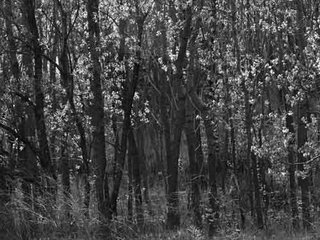
(Click for larger image)
This year we were lucky, lots of wildlife, as well as the usual seagulls and Canada Geese, there were garter snakes, rabbits and lots of songbirds.
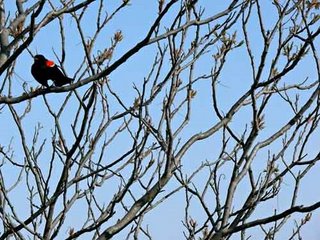
Red-winged blackbird

Warbler
Update
Marc Ferreira's shots from the Spit Shoot
Technorati tags
Toronto, photography, Leslie Street Spit
Labels: hiking, Leslie St. Spit, photography, Toronto
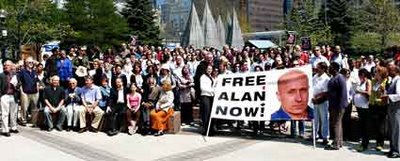
Hundreds of journalists and other supporters rallied at Toronto's Simcoe Park on Thursday May 10, 2007, to support kidnapped BBC journalist Alan Johnston, who by that time had been held in Gaza for 60 days.
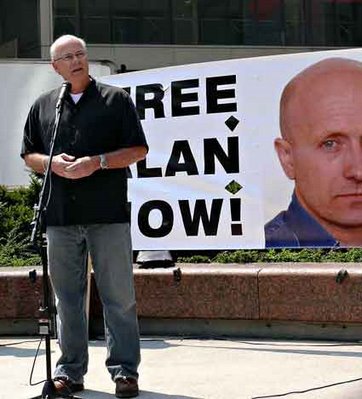
CBC Chief Correspondent Peter Mansbridge expresses his support for Alan Johnston and his family at the rally.
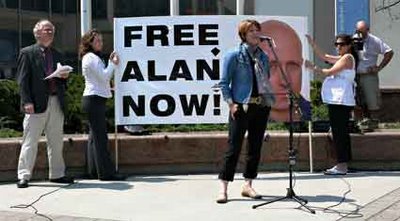
Host of CBC's The Current, Anna Maria Tremonti, a former Middle East correspondent, spoke about Alan Johnston's reporting from Gaza. Former BBC correspondent Daniel Lak who helped organize the rally is on the left.
CBC News story on the rally at Simcoe Park
CBC Editor-in-chief Tony Burman's letter calling for freedom for Alan Johnston
Sign the BBC Online petition
BBC "How You Can Help"
Toronto Star Canadian media protest kidnapping
Canadian Press story on Canoe
Daniel Lak's blog, Lakwords
Technorati tags
writing, journalism,
BBC,Alan Johnston, Gaza,CBC
Labels: Alan Johnston, BBC, Canada, CBC, Gaza, photography, Toronto
 In late March and April, 2007, I went to Montserrat to shoot the Soufriere Hills volcano. A photo galley is now up on CBC.ca (supplemented with wire pix to tell the back story).
In late March and April, 2007, I went to Montserrat to shoot the Soufriere Hills volcano. A photo galley is now up on CBC.ca (supplemented with wire pix to tell the back story).The growing lava dome looms over abandoned homes outside the town of Plymouth.
Most of the pictures were shot from a dive boat 2,000 metres off shore.
Since the dome collapse in January, 2007, you cannot enter the
exclusion zone, even with a police escort. This may change if the
volcano settles down.
I have been interested in volcanoes since I was kid, so these are in
some ways vacation pix.
I met Vicky Hard, the director of the Montserrat Volcano Observatory
and she gave me some good advice which I thought I would pass on in case
anyone ever gets an assignment to shoot a volcano.
Her most important advice was that the fine (sometimes microscopic)
volcanic ash can be deadly to cameras and computer equipment, the
observatory has to replace its equipment frequently because the ash
shortens its working life.
Every morning when I got up, I had to clean a very fine layer of ash
from the top of my (closed) laptop even though the volcano was
relatively quiet.
She said ash can destroy an SLR when changing lens (this has happened
to photographers in the past)
So if you are ever assigned to shoot a volcano, take a high quality
fixed lens camera or an SLR that is at the end of its useful life or be
prepared to pay for a thorough cleaning and overhaul when you get back.
On Vicky’s advice I did not take my SLR on the dive boat for the
shots I took from the west side of Montserrat. I used my Panasonic
Lumix FZ50, which has 450 mm equivalent optical zoom. There was some
chop and a little spray, but not that much, but I had to clean the UV
filter on the camera every few minutes. The tiny grains of ash combined
with the spray meant the UV filter quickly looked as if it had been
sitting uncovered on a shelf for about a decade.
I did use my SLR for the pictures I took on the east side of the island
from Jackboy Hill, the weather was fine, there was little wind and I was
shooting on land, with no danger of sea spray.
Technorati tags
volcano, Montserrat, photography,
Labels: Montserrat, photography, volcano
My CBC colleague Paul Gorbould of our online Archives reveals one of the secrets that Google is using to create its controversial Google Book Search, by turning high-end Nikons into a robotic scanner.
It's from a company called Kirtas, and has a total cost of about $200,000.
Details on his blog in a post called Speed Reader.
Reminds of the old sayings about using a racehorse to pull a cart.
But at least using the Nikon will likely ensure the result is readable!
As the New Yorker reported this week Google wants to scan every book ever published and this has been controversial ever since it was announced. Legal expert Jeffrey Toobin says in the story Google isn't the only outfit planning to scan every written word from Gilgamesh to Harry Potter.
Gilgamesh, at least in the original cuneiform, if you can find a copy that is not copyrighted by a museum, should have been in pubic domain for 4600 years. Harry Potter, of course, will remain copyrighted for years after the latest Harry Potter and the Deathly Hallows hits the streets in July.
And Google recently announced plans to merge Google Maps with Google Books, so, in theory, you can follow your character, fiction or non-fiction, through the streets of New York or Moscow. Although I wonder how Google Book-Maps would handle the settlements in Robert Heinlein's Moon is a Harsh Mistress
(Wikipedia entry)
I now have a "what do I have to lose" attitude about Google Book Search, especially since Toobin's article shows that the publishers are of two minds (or perhaps forked tongues) on the issue, at one end making deals with Google and on the other suing over copyright issues.
Ever since book publishing became part of media conglomerates and began selling books to the major chains, rather than the reading public, the author has become the least important person in the process. I simply assume--and most writers I know agree with this--that I am going to be ripped off anyway. So what's a little copyright infringement along the way? Perhaps if Google finds a way to pay the author's share directly for those who want to view or download copyright works, rather than going through the publishers, there will be more pluses than minuses for an author.
It's often less frustrating and more satisfying just to blog at least part of your work without having to deal with magazines that won't pay you enough for your time and effort any way or editors who write "guidelines" which are so unclear that they could have used a good copy editor. That's why I am blogging how I am building my model railway, rather than bothering to go to the magazines, which demand all rights --another ripoff.
Labels: CBC, Google, Google Book Search, Harry Potter, photography, publishing, Robert Heinlein, writing
A number of newspaper managers around the world, apparently desperate to keep their corner offices in the uncertain and unsettling world of the digital convergence are predicting the end of the still photo camera.
Some photographers, the "early adopters" are also jumping on the band wagon.
The photo is dead. Long live video they say.
They're wrong. They're throwing out the baby with the developer bath water. A sort of mixed metaphor, especially for the age of digital photography, but I hope it makes a point.
EPUK, the website for the Editorial Photographers United Kingdom and Ireland, in a story last fall, that I just came across, quoted the newly appointed Executive Editor (Pictures), Stuart Nicol, of the Daily Telegraph as saying:
“Digital stills photography will, when we look back on it, form a very small period of time in the history of photojournalism”, Nicol told EPUK. “Telegraph photographers will undoubtedly be shooting solely on video in the future, and certainly within a year we hope to be well advanced down that route.”
The article goes on to say
At the moment the quality of video stills available from small video cameras is generally below that needed to produce photographic quality. However, some US newspapers including the Detroit Free Press and Dallas Morning News have already begun shooting solely on video, at 1920×1080 pixel resolution, on cameras costing around $5000, equivalent to a high-end digital SLR body
You have to use the new High Definition cameras.
In this post on MultiMedia shooter there is a tutorial on how it is done.
I would also note that while many newspapers are adding video to their pages (just as television stations and networks are adding still photography) and both the Associated Press and the Canadian Press offer video for member websites, the quality when it is shot with a still camera or when processed just for the web is so poor that it cannot be used for broadcast unless it is the only video of an important news story.
In my view, and I have the experience, while video frame grabs can be good, there is no substitute for the still photographer and there never will be. There will still be photographers shooting stills with still cameras long after Mr. Nicol has retired from the Telegraph.
(And in checking the site, I couldn't find any images that looked as if they came from an HDTV video cam)
Shooting stills and shooting video are like two brothers or sisters. Same gene pool but different people.
For more than 10 years how, I have been grabbing frames from CBC News video for use on the CBC.ca website. I discovered very early that the trigger finger process used for on the fly frame grabs never produces a good still frame. For a good picture, you have to capture a section of the video and examine it frame by frame until you find one that has the potential for a good still picture.
If you find that one frame that captures the decisive moment and has great composition and framing and colour, you can get a good picture. But remember, at this point, with NTSC, with 515 lines,and PAL with between 575 and 625 lines, depending on the local standard, and a maximum capture of 720 x 540 pixels, you're talking the equivalent of a one megapixel camera.
The best High Definition frame is 1920 x 1080, which would roughly be the equivalent of a three to four megapixel still camera, although from what I saw from an briefing on future software developments by Adobe last fall, the fact the HDTV capture is digital does give the photo editor more to work with.
For a fast paced, money conscious news organization, the bean counters will quickly find out that it is faster for an experienced professional photo editor or photographer to scan the frames shot from a still camera with modern software and pick out the best pictures. In fact, it is highly likely that a photo editor could choose, process and send to the web or the layout desk a still picture before the video was captured and a good frame chosen for use.
Let's just give two examples where the difference between video and still photography is seen the most:
1)Speakers. A TV photographer shooting a speaker is recording the best clips. A still photographer recording the same speaker is looking for the decisive moment in the speech. You have the same moment, but the aim of the shooter is different.
The video camera records the movements of the face. In going through a series of captured frames, each frame will have a different moment of human expression.
The most difficult job in grabbing frames is not just finding a good picture, often it is finding the frame that doesn't make the speaker look an idiot, whether president or prime minister, mayor or police chief, cop on the scene or heroic kid (the politicians may be idiots but a frame grab is not the time to point that out.)
The still photographer can always do it better.
2. Action. The video shooter is looking and following the action. The camera is often moving. The current television camera captures at 30 frames per second, film at 24 frames a second and HDTV can capture at between 24 and 60 frames a second, depending on how the video is going to be used.
That means that even an HDTV camera cannot capture at any faster than 1/60 of a second. So whether it is football game, a wildlife shot or action on the street, a still photographer shooting at anywhere from 1/125 of a second to 1/1000 of a second can capture the action better. The problem is that when you look at a current NTSC frame, captured at 30 frames per second, 1/30 of a second, the action is blurred. Your eye doesn't see it on the TV screen, but it is there on the frame. You may get lucky and get the one frame that does capture the action-- I was able to do that last year with an Olympic skiing shot from the CBC broadcast that was requested by Canadian Press and run in papers across the country.
More likely you are going to get the face or the arms or the legs or the running back or the speeding car all jaggy, the equivalent of the photo blur. The only solution is to try multiple passes at deinterlacing in PhotoShop and even then it is not perfect.
The bottom line is that these are two different technologies. I have excellent 13" x 19" prints from pictures from my first 2 megapixel camera, so I am not saying it can't be done with an HDTV cam. But with the standard for consumer still cameras now at 10 megapixels, it is unlikely we will see the end of the still photographer anytime soon.
Want to compare still photos and well-processed NTSC capture images? Go the photo gallery I produced of the storm wrecked West Coast Trail on Vancouver Island, Paradise Lost, click on Open in Full Screen and see the difference between a photograph and an NSTSC screen grab.
Labels: CBC, Daily Telegraph, HDTV, news, NTSC, PAL, photography
Post updated 1700 ET
CBS Outdoor, the new name for the old Viacom billboard company could threaten the public display of photographs during the annual Contact photo festival this spring.
The Globe and Mail reports this morning that CBS which controls the advertising for Toronto's public transit system wants to charge $32,500 for the display of photographs in five bus shelters and another display of photographs, organized by the Art Gallery of Ontario, in St. Patrick subway station.
(Globe story usually public for about two weeks after publishing)
The Globe story says that when Viacom ran the system, the company charged the festival the charitable organization advertising rate. Now, according the Globe, the beancounters at CBS Outdoor are quadrupling the display rates.
Quote from the Globe
CBS Outdoor officials insisted that Contact has never received the same rates as charitable groups, and was free to renegotiate the deal. But [festival organizer Bonnie] Rubenstein said her staff received an e-mail from CBS last November, informing them of the new rates and policies, saying they were "non-negotiable."Contact has appealed for help from the city's arts division and the office of TTC chair Adam Giambrone, who said he was unable to persuade CBS to adjust the fee.
Downtown councillor Kyle Rae told the Globe that the CBS decision could threaten other arts and culture events in Toronto.
"Those are our bus shelters and there needs to be a clearer relationship between our goals as the property owner and CBS's bottom line," he said.
As the Globe article points out, many other cities around the including London's Platform for the Arts display the work of local artists in the "underground" and other transit locations.
Out of curiosity I searched New York transit art, the Big Apple of course is home to Black Rock, the corporate headquarters of CBS, and found the New York transit system Subway Art Guide.
Another black eye for CBS!
(And an example again that many in the United States think it is the centre of the universe. The US site for CBS Outoor, cbsoutdoor.com has a map of the world on its market page, but that map is not clickable. So if you miss the obscure reference on the drop down menu on the the home page, you have to hunt up the page for the international branches. The Canadian site, of course, has more visible links to the international offices, in case some poor soul searching on Google ends up in the wrong country.)
--
Update/Response
A reader, who works at CBS, sends this response:
I think the Globe got it wrong -- "when Viacom ran it"?
Essentially there is no change in the management of CBS Outdoor, just a name change.
In fact, CBS Corporation is really Viacom, just a name change for the whole company.
That's how CBS kept all the licenses.
The "new" Viacom, or MTV Networks, is essentially a whole new company after the spinoff.
Confusing yes. But I am pretty sure CBS Outdoor in Canada has the same old management it always did. Not fair to blame the EYE for this one.
- Wikepdia entry on MTV Networks
- Wikipedia entry on Viacom
- Wikepedia entry on CBS Corporation
Labels: Canada, CBS, Globe and Mail, photography, United States, web design
